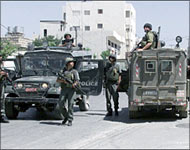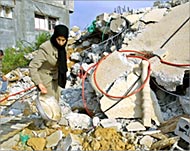Gaza’s road to nowhere
Gaza’s Salah al-Din highway, totally impassible in parts and under Israeli control along its length, runs from north to south through the 360 square kilometre strip that is home to over a million Palestinians but also sprinkled with thousands of illegal Israeli settlements.
 |
| Israeli vehicles only allowed to use the road near Bait Hanun |
For several days, an unlikely deal has been discussed as so many before – whereby the Israeli army will pull out of the reoccupied northern Gaza Strip and the southern West Bank town of Bethlehem if the Palestinian Authority takes full security responsibility.
How agreement might come is difficult to see, says Richard Curtiss, executive editor of the Washington Report on Middle Eastern Affairs.
“In the last few months the Israeli army has strengthened its grip on the Gaza Strip, creating mini security zones along the road to protect nearby Jewish settlements”, all of which are unlawful under international law.
Soldiers manning positions along the road have loose rules of engagement, he adds. The road has often been the site of frequent incidents, leading to many deaths – nearly all Palestinian.
Finally, Curtiss highlights the fact that the Israeli army has razed hundreds of houses and uprooted acres of trees and farmland to set up the small buffer zones around the settlements and their by-pass roads, while checkpoints effectively cut the Gaza Strip into three.
No go zone
At the northern end, around Bait Hanun, only Israeli military vehicles have the right to use the road.
 |
| A former home near Rafah, too close to an illegal settlement and so destroyed |
The road surface and the pavements have been torn up, and some 30 houses pulled down on each side. Children play blithely in the sandy soil near the menacing tanks, while their parents tell of their fears.
A mother of seven, named Hasna, said that when night falls she dare not show a light, because “Israeli soldiers shoot at us.” She has to cook the evening meal on a wood fire during the day.
“After 7:30 p.m. we cannot even go outside,” she added.
Hani, a 33-year-old carpenter, must walk two kilometres every day to his work in the industrial zone at the main Erez crossing point between Israel and the Gaza Strip.
“We have to walk in front of the tanks and their guns,” he said, his face covered with dust after his walk. “Every morning I say goodbye to my wife and three children without knowing if anything will happen to us.”
“We face death all the time, while we want peace and we want security,” he added.
Humanitarian disaster
Bait Hanun’s mayor, Ibrahim Hamad, said the Israelis are responsible for a “humanitarian disaster.”
“Most of the people around here have no water or electricity,” he said, accusing the army of destroying electricity transformers and water pipes and tearing up some 250 hectares of crops.
At the other end of the Salah al-Din highway at Rafah, a frequent target of Israeli incursions, the Palestinians want the Israelis to keep the crossing point into Egypt permanently open as well as allowing the international airport to operate.
The Palestinians want the Israeli army to hand over complete control of the road but Israel’s daily Haaretz quoted General Doron Almog, who heads the military region which includes Gaza, as saying on Wednesday such a move would be a “recipe for disaster”. A comment which seems to imply the current situation is not a disaster.